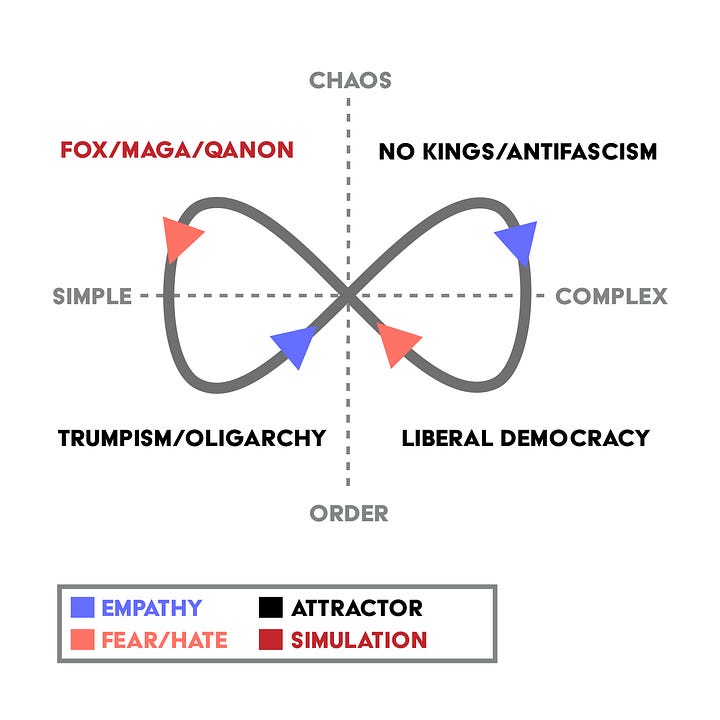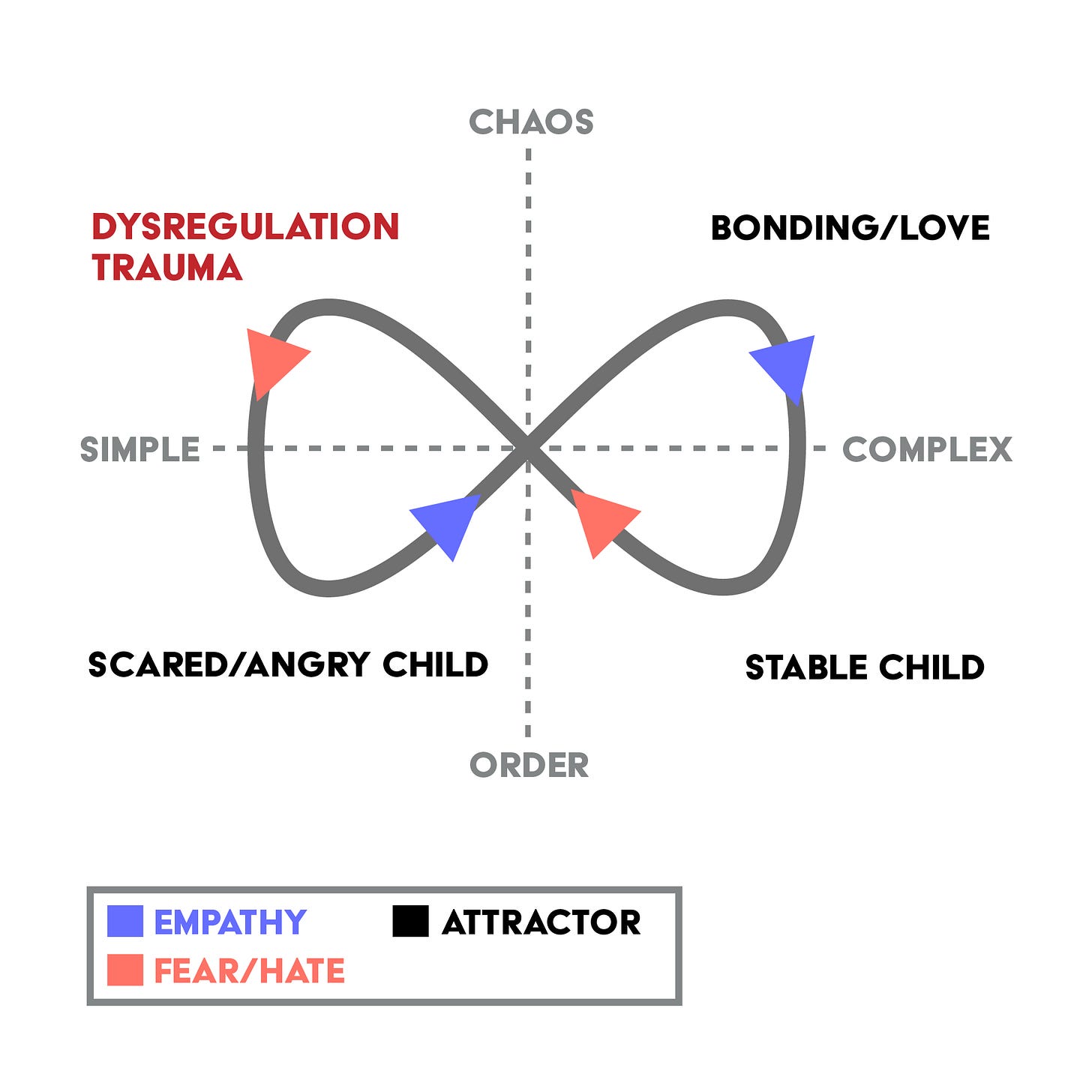Open Adaptive Systems Theory & the War on Complexity
One simple trick for healing minds — or collapsing societies.
Your toddler is in an endless loop: “No!” has taken over their entire vocabulary. Reasoning with them is no good—trying to bribe them makes them angrier. So you just hug them and tell them it’s going to be ok. They might resist for a minute, but more often than not they’ll settle down, process whatever triggered them, and ask for a snack and a TV show.
In this article, I will show how this common interaction is a small-scale example of how all open, adaptive systems—whether a child or a society—behave, and how dictators and oligarchs weaponize this universal dynamic for their own purposes.
The diagram below depicts a child’s emotional state as a system and how they normally process trauma and dysregulation. Each quadrant represents a familiar emotional state in a natural transition cycle:
Upper-left: Dysregulation is introduced to a stable child—whether due to internal stress or external trauma.
Lower-left: After an initial reaction, the child becomes rigid, single-focused, defiant—“No!”
Upper-right: A parent, or other trusted person introduces empathy, love, bonding. This breaks the child out of their hyperfocus.
Lower-right: The child settles back down into a normal rhythm.
As the father of three sons, I know it’s a lot more complicated than this, but the dynamics here are what’s important.
The diagram above is an example of a much broader principle that I call Open Adaptive Systems Theory (OAST), which integrates complexity and systems theory and has significant descriptive and predictive power, applicable to a wide range of systems: subatomic, financial, psychological, and geopolitical.
Here is the same chart of a child’s emotional system, adding two axes (Simple → Complex) and (Order → Chaos). “Simple” here means narrow, rigid, low-dimensional patterns; “complex” means flexible, multi-dimensional patterns of behavior. I’ve also added attractor to the legend, which is a mathematical principle that means complex systems have a tendency to settle into specific, pre-determined patterns.
The arrows show the direction these systems always go, and how they create an infinite loop, or to be more specific, a lemniscate: ∞. This is mathematically significant in dynamical systems theory.
A lemniscate (∞) is a mathematical figure-eight curve that represents a system cycling between states. An attractor is a pattern toward which a complex system naturally settles, even as it moves through turbulence.
Below is a version of the chart with the quadrants generically labeled. Note the blue and red arrows represent the dynamic forces of binding and unbinding, which are ubiquitous throughout physical and biological systems, from empathy and the strong nuclear force to entropy and bigotry.
There are just four attractors for all open, far-from-equilibrium systems: Simple Chaos (SC), Simple Order (SO), Complex Chaos (CC), Complex Order (CO). These systems are governed by binding and unbinding dynamics that push complex systems through a cycle: SC → SO → CC → CO → SC → …
Importantly, this is not deterministic nor is it fatalistic in the sense of any particular outcome for any particular system, it is a dynamic that shows how systems naturally flow—and how they can be manipulated by external forces. These quadrants are not moral judgments, they are descriptive states—attractors that appear in many open systems.
Let me give an example a little closer to my usual subject matter, and show why I developed this particular theory. Here are two more OAST charts showing the same political dynamic, with one important difference.
The chart on the left shows a common cycle of political regeneration and collapse: dictatorship leads to revolution, which settles into stable pluralism, which is brought down by disintegration and anarchy, leading back to authoritarianism to “solve” it. On the right, I’ve mapped this on the the current political struggle in the United States.


Historical examples of this dynamic are ubiquitous, including:
The Ancien Régime → French Revolution → Pluralistic Republic → Disintegration into Napoleonism
German monarchy → WWI → Weimar Republic → Nazi Germany
Tsarist Autocracy → Russian Revolution → NEP Stabilization → Stalinist Purges
Roman Oligarchy → Hundred Year Civil War → Augustus, early Principate → Third Century Collapse
While all autocracies have used information control as part of their strategy, the Trump regime is unique in the extent to which it has simulated the attractor of Simple Chaos—of anarchy. From a complexity perspective this is a deliberate effort to force the system into Simple Order—dictatorship. This concentrates power and benefits exactly the people who fund and run the simulation.
From a common sense perspective, no functioning pluralistic democracy is going to suddenly throw up its hands and become a dictatorship, right? You must have the interim step. You need chaos. You need anarchy.
But what if you can’t actually create anarchy, so instead you construct the perception of total chaos? What if you set up massive cable, social media, and influencer networks to just tell people all day that the world is going to hell? What if you build a Simple Chaos alternate reality attractor?
The natural dynamic of a state in Simple Chaos is to settle into Simple Order. A noisy, chaotic state doesn’t suddenly become more complex, it tries to minimize energy and noise in the system; it simplifies itself. This is why chaos is the dictator’s lifeblood. He needs it, so he can “solve” it through autocratic control.
None of this means we are deterministically doomed to go through anarchy before falling into a dictatorship—all before we even have a chance of getting back to normal. Not at all. This assumes two facts not in evidence:
Despite running a Simple Chaos simulator for a decade, with nearly a year in power again to turn it into reality through violent paramilitaries, tariffs, and foreign adventurism, the country still refuses to break down into tears and terror.
The effort to unbind America by destroying empathy isn’t working to plan—to the contrary, it appears that the opposite is happening. It turns out empathy is not something you can just take away from people. It’s built in to the system.
The same people who built the simulation are the people who declare empathy to be “suicidal” because it is all part of the same project: to destabilize our Complex Order into Simple Chaos, so they can profit from the Simple Order of Bitcoin, Tesla, Palantir and Donald Trump.
It is a malignant twin of America, parasitizing and disintegrating our pluralistic system based on a simulated alternate reality. It is doomed to fail, not because it is immoral, but because it is based in a deeply unstable set of conditions. The only question is how long the simulation sustains itself. Based on recent glitches, the timeline may be nearing.
“It is utterly implausible that a mathematical formula should make the future known to us, and those who think it can would once have believed in witchcraft.”
—Jacob Bernoulli, discoverer of the lemniscate: ∞
If you are able to help me continue my work, please consider upgrading to a paid subscription. It really means a lot. Thank you!
Here are a few benefits to upgrading:
Live Zoom call each Sunday
Ability to comment and access all content
Wonderful, supportive community
Helping independent journalism fill in the gaps for our failing media
Thank you for reading and sharing my work. Grateful for your support.
If you’d like to help with my legal fees: DefendSpeechNow.org.
My podcast is @radicalizedpod & YouTube — Livestream is Fridays at 1PM PT.
Bluesky 🦋: jim-stewartson
Threads: jimstewartson








Brilliant Jim! I'll have to re-read this a few times to really get it, but worth the effort!